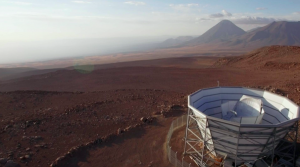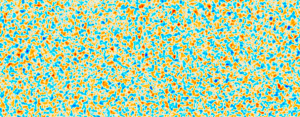New View of Nature’s Oldest Light Adds Fresh Twist to Debate Over Universe’s Age
Observations by the Atacama Cosmology Telescope suggest that the universe is 13.8 billion years old.
July 15, 2020 – From a mountain high in Chile’s Atacama Desert, astronomers with the National Science Foundation’s Atacama Cosmology Telescope (ACT) – including researchers with the Dunlap Institute for Astronomy & Astrophysics, the David A. Dunlap Department of Astronomy & Astrophysics, and CITA – have taken a fresh look at the oldest light in the universe. Their new observations plus a bit of cosmic geometry suggest that the universe is 13.77 billion years old, give or take 40 million years. The new estimate matches the one provided by the standard model of the universe and measurements of the same light made by the Planck satellite.

The Atacama Cosmology Telescope measures the oldest light in the universe, known as the cosmic microwave background. Using those measurements, scientists can calculate the universe’s age.
This adds a fresh twist to an ongoing debate in the astrophysics community, says Simone Aiola, first author of one of two new papers on the findings posted to arXiv.org. In 2019, a research team measuring the movements of galaxies calculated that the universe is hundreds of millions of years younger than the Planck team predicted. That discrepancy suggested that a new model for the universe might be needed and sparked concerns that one of the sets of measurements might be incorrect.

A portion of a new picture of the oldest light in the universe taken by the Atacama Cosmology Telescope. This part covers a section of the sky 50 times the moon’s width, representing a region of space 20 billion light-years across. The light, emitted just 380,000 years after the Big Bang, varies in polarization (represented here by redder or bluer colors). Astrophysicists used the spacing between these variations to calculate a new estimate for the universe’s age.
“Now we’ve come up with an answer where Planck and ACT agree,” says Aiola, a researcher at the Flatiron Institute’s Center for Computational Astrophysics in New York City. “It speaks to the fact that these difficult measurements are reliable.”
The age of the universe also reveals how fast the cosmos is expanding, a number quantified by the Hubble constant. The ACT measurements suggest a Hubble constant of 67.6 kilometers per second per megaparsec. That means an object 1 megaparsec (around 3.26 million light-years) from Earth is moving away from us at 67.6 kilometers per second due to the expansion of the universe. This result agrees almost exactly with the previous estimate of 67.4 kilometers per second per megaparsec by the Planck satellite team, but it’s slower than the 74 kilometers per second per megaparsec inferred from the measurements of galaxies.
“I didn’t have a particular preference for any specific value — it was going to be interesting one way or another,” says Steve Choi of Cornell University, first author of the other paper posted to arXiv.org. “We find an expansion rate that is right on the estimate by the Planck satellite team. This gives us more confidence in measurements of the universe’s oldest light.”
“Our main goal with these papers was to produce independent constraints on our model of cosmology from Planck,” explains Dunlap Institute and University of Toronto Assistant Professor Renée Hložek. Hložek says that the constraints presented are an independent measurement of the Hubble constant, addressing one of the most pressing questions in contemporary cosmology. “There is still more work to do as we analyze more data, but it’s an exciting new piece of the puzzle.”
The analysis of the ACT data to produce these pristine maps was made possible through annual large allocations of computing cycles from SciNet and Compute Canada. SciNet is a high-performance computing facility that houses Canada’s largest supercomputer centre, Niagara, which provides Canadian researchers with computational resources and expertise necessary to perform their research on scales not previously possible in Canada. Compute Canada is funded by the Canada Foundation for Innovation, the Government of Ontario, and the University of Toronto. The research of Professors Richard (Dick) Bond and Hložek is also supported by NSERSC Discovery Grants program, and through CIFAR. “I’m really lucky to be able to be a part of international collaborations through support from Canada, especially as an early career scientist,” says Hložek.
Like the Planck satellite, ACT peers at the afterglow of the Big Bang. This light, known as the cosmic microwave background (CMB), marks a time 380,000 years after the universe’s birth when protons and electrons joined to form the first atoms. Before that time, the cosmos was opaque to light.
If scientists can estimate how far light from the CMB traveled to reach Earth, they can calculate the universe’s age. That’s easier said than done, though. Judging cosmic distances from Earth is hard. So instead, scientists measure the angle in the sky between two distant objects, with Earth and the two objects forming a cosmic triangle. If scientists also know the physical separation between those objects, they can use high school geometry to estimate the distance of the objects from Earth.
Subtle variations in the CMB’s glow offer anchor points to form the other two vertices of the triangle. Those variations in temperature and polarizati¬¬on resulted from quantum fluctuations in the early universe that got amplified by the expanding universe into regions of varying density. (The denser patches would go on to form galaxy clusters.) Scientists have a strong enough understanding of the universe’s early years to know that these variations in the CMB should typically be spaced out every billion light-years for temperature and half that for polarization. (For scale, our Milky Way galaxy is about 200,000 light-years in diameter.)
ACT measured the CMB fluctuations with unprecedented resolution, taking a closer look at the polarization of the light. “The Planck satellite measured the same light, but by measuring its polarization in higher fidelity, the new picture from ACT reveals more of the oldest patterns we’ve ever seen,” says Suzanne Staggs, ACT’s principal investigator and the Henry deWolf Smyth Professor of Physics at Princeton University.
As ACT continues making observations, astronomers will have an even clearer picture of the CMB and a more exact idea of how long ago the cosmos began. The ACT team will also scour those observations for signs of physics that doesn’t fit the standard cosmological model. Such strange physics could resolve the disagreement between the predictions of the age and expansion rate of the universe arising from the measurements of the CMB and the motions of galaxies.
“We’re continuing to observe half the sky from Chile with our telescope,” says Mark Devlin, ACT’s deputy director and the Reese W. Flower Professor of Astronomy and Astrophysics at the University of Pennsylvania. “As the precision of both techniques increases, the pressure to resolve the conflict will only grow.”
The ACT team is an international collaboration, with scientists from 41 institutions in seven countries. The University of Toronto (Including the David A. Dunlap Department of Astronomy & Astrophysics), the Dunlap Institute for Astronomy & Astrophysics, and CITA (the Canadian Institute for Theoretical Physics) play an essential role in ACT, through the contributions of their members, including Dick Bond (CITA), Renée Hložek (Dunlap/University of Toronto), Adam Hincks (University of Toronto), Mike Nolta (Compute Canada), and Martine Lokken (Dunlap/University of Toronto). Several Toronto alumni are also on the paper, including George Stein and Marcelo Alvarez (now at Lawrence Berkeley National Lab, and Alex van Engelen (now at Arizona State University).
The data presented is the most sensitive CMB microwave data over half the sky (the image above is 25 degrees across, 50 times the moon’s diameter on the sky, or 20 billion light years across in distance). The image represents only a small part of the ACT data, which now in total covers almost half of the sky.
Source: Dunlap Institute for Astronomy and Astrophysics, University of Toronto
- 430 reads
Human Rights
Fostering a More Humane World: The 28th Eurasian Economic Summi

Conscience, Hope, and Action: Keys to Global Peace and Sustainability

Ringing FOWPAL’s Peace Bell for the World:Nobel Peace Prize Laureates’ Visions and Actions

Protecting the World’s Cultural Diversity for a Sustainable Future

Puppet Show I International Friendship Day 2020

